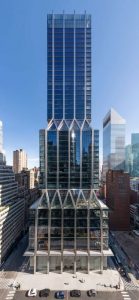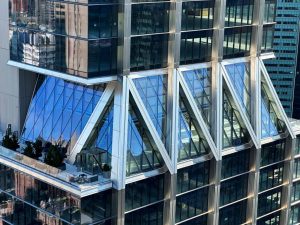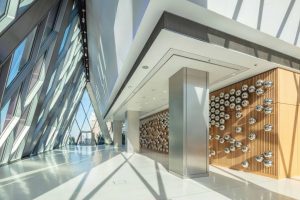425 Park Avenue is the first full-block office building on N.Y.’s Park Avenue in over 50 years. It is located alongside other modernist icons such as the Seagram Building, Lever House, and the CBS Building, and provides ample views of Central Park and the neighborhood.

The 47-story tower was designed by Foster + Partners in close collaboration with L&L Holding’s project team. It includes a triple-height lobby, office accommodation, external green spaces, an expansive social amenity level, and a 11.6-m-(38-ft)-tall penthouse floor. Built to Leadership in Energy and Environmental Design (LEED) Gold standard, the building has earned Well Core certification at Gold level, in recognition of its features, which enhance the health and wellbeing of occupants.
The tower is divided vertically into three distinct volumes: a seven-story base, knitted into the urban grain at street level; a recessed central section; and a slender formation of premium floors at the top. The design was established through a process of detailed analysis, involving modeling views of Central Park from the site, and finding the ideal distribution of areas to achieve a balanced composition.
The first set back—a characteristic feature of high-rise design in New York—corresponds with the datum of the street. The second set back develops this theme, which is physically and symbolically setting the upper levels apart from the rest of the city’s office towers. To maximize the Park Avenue frontage, the core is placed to the rear, where glazed elevator lobbies bring life to the eastern elevation and reveal long views towards the East River.

Clearly expressing the structure, the tapered steel and concrete framed tower rises to meet three shear walls—extending beyond the top of the tower, these three blades provide a marker on the skyline. The structural expression of the building allows for flexible, column-free floorplates on the upper levels, which can accommodate a wide range of tenants.

Between each of the three volumes, the office floors are intersected by double-height spaces that create the prized amenity of open space in the heart of Manhattan. The second setback features The Diagrid Club, which is open to all the tower’s tenants. This club offers views, outdoor areas, an art installation by the Japanese contemporary artist Yayoi Kusama, private rooms for transcendental meditation by the David Lynch Foundation, and a number of curated amenities designed to connect the mind and body.





Responses